Amethyst
The world's most popular purple gem. Birthstone for February.
Author: Hobart M. King, PhD, GIA Graduate Gemologist
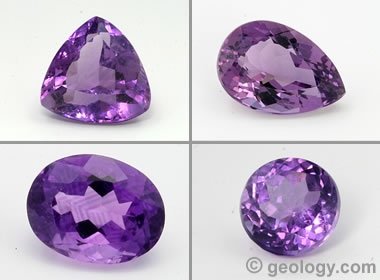
Faceted Amethyst: Most amethyst used in jewelry is cut as faceted stones. Shown above are four popular shapes. Clockwise from top left: a trillion, a pear, a round, and an oval.
The oval shows strong color zoning that is very common in natural amethyst and not usually seen in synthetic amethyst.
Amethyst is...
- the world's most popular purple gem
- the modern birthstone of February
- the purple color variety of quartz
- a gem used for over 2000 years
- one of the most affordable gems
- a popular New Age gem
- heated to produce citrine and prasiolite
Table of Contents
What is Amethyst?
Amethyst is the world's most popular purple gem. It is the purple color variety of quartz that has been used in personal adornment for over 2000 years.
Amethyst is the birthstone of February and an important New Age gem. It is used to produce faceted stones, cabochons, beads, tumbled stones, and many other items for jewelry and ornamental use.
Amethyst has a Mohs hardness of 7 and does not break by cleavage. That makes it durable enough for use in rings, bracelets, earrings, pendants, and any type of jewelry. Enormous deposits of amethyst in South America and Africa provide enough amethyst to keep the price low. Most people can easily afford amethyst.
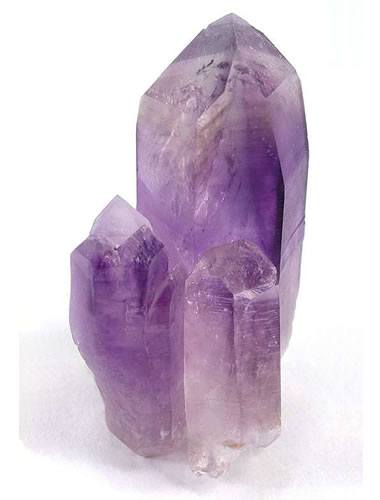
Amethyst crystals: Three amethyst crystals from Pisco Province, Peru. This specimen measures 6.6 x 4.3 x 3.7 cm. Specimen and photo by Arkenstone / www.iRocks.com.
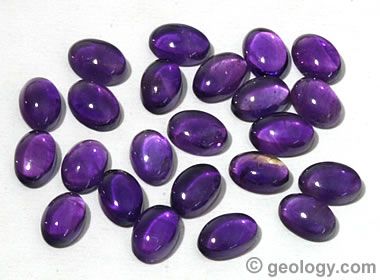
Amethyst cabochons: A scatter of small amethyst cabochons cut to a calibrated size of 6x4 millimeters. These cabs were cut from rough with a rich purple color that allows them to remain richly colored at this small size.
Color in Amethyst
Amethyst is an extremely popular gem because of its attractive purple color. Like the word "turquoise," the word "amethyst" is now the name of a color as well as the name of a gem material.
While the word "amethyst" makes most people think of a dark purple gem, amethyst actually occurs in many purple colors. The purple color can be so light that it is barely perceptible or so dark that it is nearly opaque. It can be reddish purple, purple, or violetish purple. Amethyst exists in this wide range of colors.
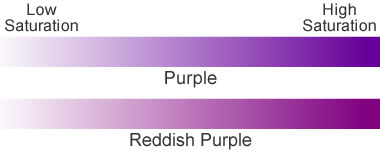
The graphic above illustrates two ranges of amethyst color. Purple and reddish purple amethyst occur in saturations that range from a color that is barely perceptible to a color that is rich and vivid.
Today much of the light amethyst is used to cut small calibrated stones for use in mass-market jewelry. Most of the premium reddish purple color amethyst is being used in high-end or designer jewelry.
Creative people have come up with a variety of adjectives to describe shades of amethyst. These include: orchid and lavender for lighter colors; grape, indigo or royal for darker colors; and raspberry or plum for reddish colors. While these names can be useful in conveying a generalized color, they are by no means precise or clearly understood by everyone.
With a combination of attractive colors, good durability, and affordability, it is no wonder that amethyst is a favorite gem of artisans, jewelers, craftspeople, and consumers.
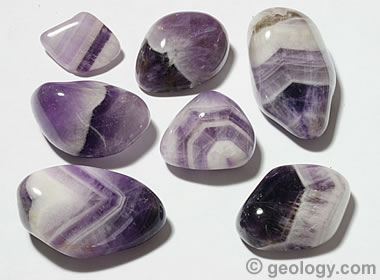
Tumbled stones: Amethyst is very popular as a tumbled stone. Shown above are tumbled stones made of banded amethyst, sometimes called "chevron" amethyst because of its V-shaped pattern. This is an extreme example of color zoning within a single amethyst crystal. The color varies from overly dark purple, to dark purple, to medium purple, to light purple, and to plain white quartz. A touch of smoky quartz is visible in two stones. Each band represents a different episode of crystal growth and crystallization conditions. These stones are from material produced in Namibia. The largest is about 1 1/2 inches long.
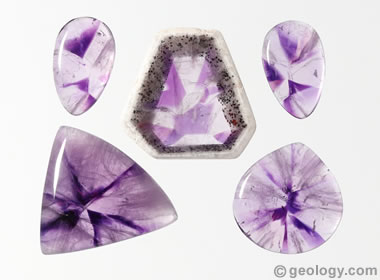
Color Zoning in Amethyst: Amethyst cabochons with interesting color zoning. Each cabochon was cut from a thin slice of a color-zoned amethyst crystal that was sliced perpendicular to its c-axis. It is interesting how color can be concentrated into certain sectors of a growing crystal. Some people call these color-zoned slices "trapiche-like amethyst".
Amethyst Crystals
The first step in amethyst receiving its purple color begins during crystal growth. That is when trace amounts of iron are incorporated into a growing quartz crystal. After crystallization, gamma rays, emitted by radioactive materials within the host rock, irradiate the iron to produce the purple color.
The intensity of amethyst's purple color can vary from one part of the crystal to another. These color variations, known as "color zoning," are caused by varying amounts of iron being incorporated into the crystal during different stages of crystal growth.
Amethyst crystals grow slowly and the composition of the fluids delivering the iron and the silica needed for crystal growth can vary. The darkest color of amethyst forms when the largest amount of iron is incorporated into the growing crystal. That is what causes color zoning.
Color zoning influences the marketability and value of amethyst. Most people want a gem with a rich and uniform color. As a result, gems of uniform color - no color zoning - are the most desirable and the most valuable.
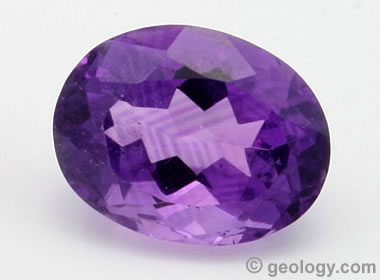
Color Zoning in Amethyst: Amethyst crystals grow slowly, and the composition of the waters from which they grow can change over time. As the composition of the water changes, varying amounts of iron are incorporated into the surface of the crystal. Later, radiation emitted by minerals in the surrounding rock modify the iron to produce the purple color. This can cause the crystal to have zones of different color intensity. Each of these zones records a time interval in the growth of the crystal similar to the growth rings of a tree. The gem in the photo above shows dramatic color zoning. Although this is geologically interesting, the most preferred amethyst gems have a rich, uniform color.
Physical Properties of Amethyst
The physical properties of amethyst are almost identical to the physical properties of other color varieties of quartz. The only important difference is the color of the material.
Physical Properties of Amethyst |
|
| Chemical Classification | Silicate |
| Color | By definition, amethyst is purple in color, the most popular color is a reddish purple with rich saturation. |
| Streak | Colorless (harder than the streak plate) |
| Luster | Vitreous |
| Diaphaneity | Transparent to translucent |
| Cleavage | None - typically breaks with a conchoidal fracture |
| Mohs Hardness | 7 |
| Specific Gravity | 2.6 to 2.7 |
| Diagnostic Properties | Conchoidal fracture, glassy luster, hardness, purple color |
| Chemical Composition | SiO2 |
| Crystal System | Trigonal |
| Uses | Faceted stones, cabochons, beads, tumbled stones, ornamental objects. |
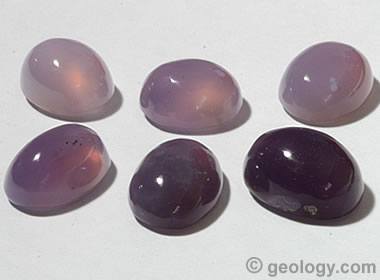
Purple Chalcedony: Chalcedony can occur in a wide range of purple colors. It is often improperly called "amethyst" or "amethyst chalcedony."
Why are those names improper? They are improper because purple quartz (amethyst) and chalcedony are two different gemological materials. The name chalcedony is used for microcrystalline quartz -- quartz that is in crystals so small that they cannot be seen without the aid of a microscope.
Fortunately, it is easy to tell the difference between quartz and chalcedony. Quartz has a vitreous luster on conchoidal fracture faces, while chalcedony has a dull luster on conchoidal fracture faces.
If you use a hand lens or a microscope to examine the facet junctions on a faceted stone or the boundary between the flat base of a cabochon and its domed sides, you can usually find at least one tiny conchoidal fracture. There is where you can observe the luster. These materials also have a difference in refractive index.
Purple chalcedony and lilac chalcedony, are acceptable names for this material. The name "amethyst" is an incorrect varietal name when used as an adjective for chalcedony.
Geologic Occurrence of Amethyst
Small amounts of amethyst are found at many locations throughout the world in igneous, metamorphic, and sedimentary rocks. Faceting, cabbing and ornamental grade amethyst can be found in all of these locations; however, the amount is usually insufficient to support an ongoing mining operation.
The world’s most important amethyst deposits are usually found in the fractures and cavities of igneous rocks. In Brazil and Uruguay large amounts of amethyst are found in the cavities of basalt flows. Large cavities can contain hundreds of pounds to several tons of amethyst crystals.
Smaller cavities, known as geodes, are often opened in a way that displays the crystals inside and then fitted with a base that allows them to be used as home or office decor. They are popular sales items at rock shops and mineral shows.
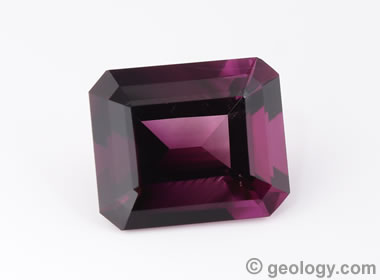
Arizona Amethyst: A beautiful reddish-purple amethyst from the Four Peaks Mine, Maricopa County, Arizona. Four Peaks is the most important amethyst mine in the United States and is famous for producing amethyst with a reddish-purple color. This is a 10.5 x 8.5 millimeter gem, weighing about 3.15 carats. It was cut by Jack Lowell of ColoradoGem.com.
Other productive amethyst deposits are located in Canada, France, India, Madagascar, Mexico, Morocco, Myanmar, Namibia, Russia, South Africa, Sri Lanka, Tanzania, and the United States.
Amethyst has been produced at many locations in the United States. Much of it has been as a byproduct of other mining operations. Today, the only commercially run amethyst mine in the United States is the Four Peaks Mine in Arizona. The mine is well known for producing amethyst with a reddish purple color. The deposit was also known by Native Americans because a few amethyst arrowheads have been found nearby. Some of the amethyst in the Spanish crown jewels may be from this deposit, brought back to Spain by Spanish explorers. [1]
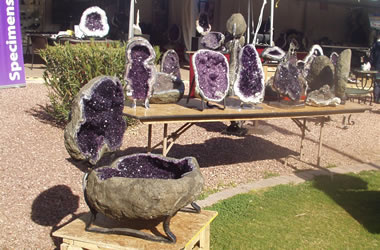
Amethyst Geodes from Uruguay on display at the Tucson Gem and Mineral Show. These were recovered from Catalan basalt at La Veronica tunnels, near Artigas city, Uruguay.
Amethyst by the Ton
Amethyst is best known as a purple, transparent, faceted gem that is sold by the carat. However, most of the world’s amethyst production is commercial products that are sold by the pound, kilogram or ton. These include amethyst geodes, amethyst crystal plates, amethyst crystals and amethyst tumbled stones.
The amethyst geode market is very strong, with many tons of them being sold at the Tucson Gem and Mineral Show alone. Small amethyst geodes are one of the most ubiquitous geological items offered for sale. They can be found at gem shows, rock shops, metaphysical stores, and novelty shops around the world.
World Amethyst Production | |||||
| Country | 2006 | 2008 | 2011 | 2014 | 2016 |
| Bolivia | 176 | 228 | 480 | 189 | 152 |
| Brazil | 3,800 | 4,200 | 4,710 | 10,977 | 4,800 |
| Tanzania | 75 | 107 | 45 | 29 | 30 |
| Uruguay | 468 | 520 | 1,000 | 1,400 | 1,300 |
| Zambia | 1,100 | 880 | 870 | 756 | 965 |
| Other | 40 | 40 | 120 | 140 | 140 |
| Total | 5,700 | 6,000 | 7,200 | 13,500 | 7,400 |
| The United States Geological Survey estimated the world’s commercial amethyst production between 2006 and 2016. Much of this production is sold in the form of geodes, crystal plates, crystals, and tumbled stones. An amazing amount of amethyst is being produced. Data from the United States Geological Survey. [5] | |||||
The geodes can be small enough to hold in the palm of your hand, or enormous sections of lava tubes that can be several meters long and weigh several tons. People buy them for home decor, mineral collections, and metaphysical use or just because they like them.
The United States Geological Survey has estimated the world’s commercial amethyst production between 2006 and 2016. Bolivia, Brazil, Tanzania, Uruguay and Zambia were the countries with the highest production. Statistics on their production are shown in the accompanying table.
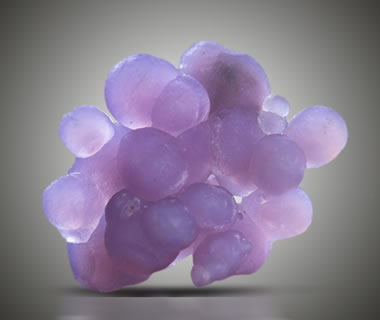
Grape Agate is the name of a popular mineral specimen. The material is not agate; instead, a more proper name would be botryoidal quartz. Even though the name "grape agate" is a misnomer, mineral collectors have hung on to the name because it is more fun and memorable than "botryoidal amethyst". Photo copyright iStockphoto / halock.
"Grape Agate" or Botryoidal Amethyst?
In 2016, mineral dealers began selling specimens of "grape agate". The specimens were composed of tiny purple spheres that ranged in size between about 2 and 8 millimeters across (see accompanying photo). The specimens were called "grape agate" because of their purple color, their botryoidal habit (from the Greek botrys, meaning a "bunch of grapes"), and because of their translucent appearance. "Grape agate" quickly became a popular new mineral specimen because of its wonderful color, fun name, and interesting appearance.
However, a few people questioned the identity of the material, doubting that agate was the proper name. When it was noticed that the grapes had a drusy surface (drusy means "covered with crystals"), the identity of "agate" was realized to be incorrect. Why? Because agate, as a variety of chalcedony, has a microcrystalline texture, while common quartz has a crystal size that can be recognized with the unaided eye or with only a low level of magnification.
Although specimens of this material are still called "grape agate", a more appropriate name is "botryoidal amethyst". In the gem and mineral trade, incorrect names such as "grape agate" are called "misnomers".
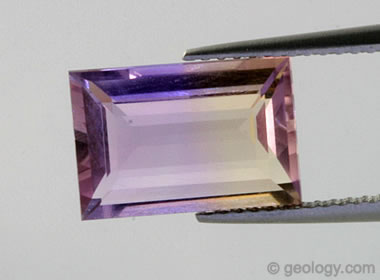
Faceted Ametrine: Ametrine has traditionally been faceted in the emerald cut with approximately 1/2 of the stone composed of citrine, 1/2 composed of amethyst, and the dividing line between the color zones perpendicular to the table. This stone has been cut to display the two colors of quartz. It is a 12x8 millimeter emerald-cut ametrine weighing approximately 3.5 carats.
Ametrine
One of the world’s most interesting gem materials is ametrine. It is a variety of bicolor quartz in which citrine and amethyst occur in contact with one another in a single crystal. The word AMEthyst and ciTRINE were combined to yield the name "ametrine." This gem material is rarely found in nature, and the only commercial production is from the Anahi Mine in eastern Bolivia. There the bicolor quartz crystals have formed within the fractures and vugs of a dolomitic limestone of the Murcielago Group. [2]
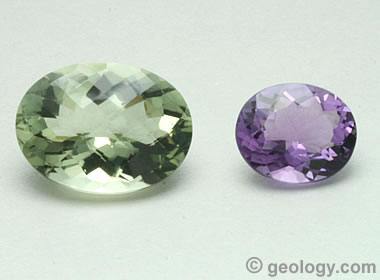
Prasiolite and Amethyst: Two faceted stones, prasiolite on the left and amethyst on the right. Prasiolite is a yellowish green to green material that is produced when natural amethyst is heated or irradiated. Most consumers are not familiar with prasiolite, and for that reason it is not often seen in commercial jewelry. The amethyst and prasiolite in this photo were both cut from material mined in Brazil.
Amethyst Treatment to Citrine and Prasiolite
The color of amethyst can often be modified by heating. Much of the yellow to golden quartz sold as "citrine" is actually amethyst that has been modified by heating. This heating can be natural or done intentionally by people.
Natural or intentional heating can also change the color of amethyst to a pale green. The proper name for this material is prasiolite; however, many sellers call it "green amethyst." These sellers run the risk of legal action from their customers or the Federal Trade Commission, who say that "it is unfair or deceptive to describe a product with an incorrect varietal name." In fact, the Federal Trade Commission has used "green amethyst" and "yellow emerald" as examples of potentially misleading names. [3]
Some prasiolite is also produced by irradiation of natural amethyst. This produces prasiolite with a lighter green color. This color can be lost if the material is heated to temperatures over 150 degrees Celsius.
Heating is also used to lighten the color of extremely dark amethyst or eliminate a brown tint that can be seen in many natural materials.
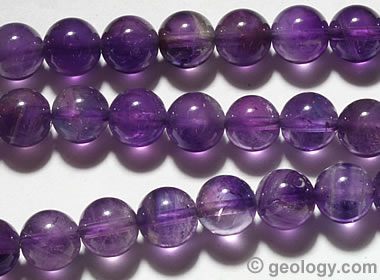
Amethyst beads: Amethyst is the most popular purple gem material used to make beads. The beads in the photo above are 8 millimeter rounds.
Care of Amethyst Gems and Jewelry
Amethyst is a durable gemstone, but some care is needed to maintain its polish and natural color. Amethyst has a Mohs hardness of 7, and that is generally considered hard enough for almost any jewelry use.
However, with a hardness of 7, it can come in contact with a variety of common objects that can produce a scratch on its surface. Accidental scrapes on hard objects or abrasion with other gems of equal or greater hardness in a jewelry box can cause damage. Amethyst is also a brittle material that can be chipped or scratched by impact. It is best not to wear amethyst jewelry during an activity or at a location where this might occur.
Long-term storage of amethyst and amethyst jewelry is best done in a jewelry box or other dark location. The color of some amethyst can be subject to fading by prolonged exposure to direct sunlight or bright display lights.
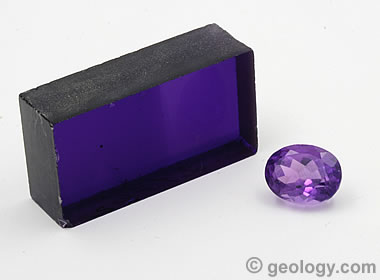
Synthetic amethyst: Much synthetic amethyst is produced by the hydrothermal process and used to make faceted and cabochon gemstones. It has the same physical properties and chemical composition as natural amethyst. Even though amethyst is one of the more modestly-priced gemstones, the price advantage of synthetic material is significant. Synthetic amethyst is often sold undisclosed as natural amethyst.
Synthetic Amethyst
Even though amethyst is not an extremely costly material, synthetic amethyst has been manufactured at least as far back as 1970. Since then an enormous number of items have been produced from synthetic amethyst by faceting, cabbing and carving. These have entered all levels of the jewelry trade. This has disappointed many jewelry consumers and made them hesitant to purchase amethyst.
Experienced gemologists can identify some natural amethyst with a microscope if it exhibits color zoning and contains characteristic mineral inclusions. However, much of the natural amethyst is of a very high clarity grade, and finding identifying inclusions can be difficult or impossible.
In the early days of synthetic amethyst, most synthetic material did not exhibit Brazil law twinning, which is almost always present in natural amethyst. This could be used to identify some synthetic material, but when synthetic amethyst manufacturers learned of this, they began using twinned amethyst slices as seed crystals. Now almost all synthetic amethyst is coming out of the lab with Brazil law twinning.
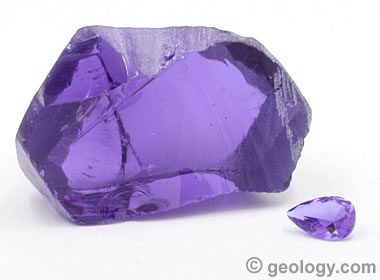
Amethyst imitations: A variety of man-made materials are used to simulate amethyst. Shown here are a faceted stone and a piece of rough. These are a Russian glass-ceramic material known as Nanosital.
Amethyst Simulants
Purple is a popular gemstone color and although natural amethyst is relatively inexpensive, some simulant materials are used. Purple glass is the most common and least expensive. Purple synthetic corundum is a more durable and convincing simulant.
Another amethyst simulant is Nanosital, a man-made glass-ceramic that is manufactured in Russia in a variety of gemstone look-alike colors. One of these is a rich purple material that is sold as an amethyst simulant. It can easily be separated from natural amethyst with a polariscope. To do that, cross the polarizing filters, place the stone on the lower polarizing filter, then rotate the stone. Natural amethyst will produce an obvious blink while Nanosital will remain dark in any orientation.
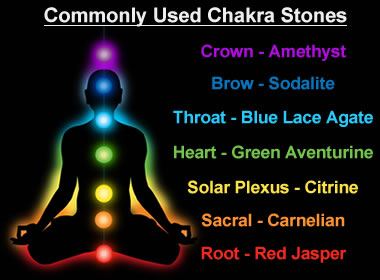
Chakra stones: Amethyst is the most popular purple gem used as a chakra stone. Chakras are "spiritual centers" of the body. Commonly used chakra stones include: amethyst (crown chakra), sodalite (brow chakra), blue lace agate (throat chakra), green aventurine (heart chakra), citrine (solar plexus chakra), carnelian (sacral chakra), and red jasper (root chakra). Image copyright iStockphoto / Artecke.
| Amethyst Information |
|
[1] About the Four Peaks Amethyst Mine: Article on the FourPeaksMining.com website, last accessed July 2022.
[2] Ametrine: an article on the Geology.com website, last accessed July 2022. [3] Guides for the Jewelry, Precious Metals, and Pewter Industries, proposed revisions; Federal Trade Commission; 16 CFR Part 23, 2015. Link to excerpt. [4] A Simple Procedure to Separate Natural from Synthetic Amethyst on the Basis of Twinning: by Robert Crowningshield, Cornelius Hurlbut, and C. W. Fryer, Gems & Gemology, Fall 1986, pages 130-139. [5] Trends in World Colored Gemstone Production, 2006 - 2016: by Thomas Yager, Gems & Gemology, Fall 2018, pages 324-325. |
Amethyst as a Healing Stone?
People have collected gem materials for thousands of years and marveled over their beauty. Through time and in all parts of the world, many people have believed that gem materials have the ability to heal, protect, or comfort a person who owns or wears them.
Even though there is no scientific evidence that gemstones have any healing or spiritual power, many people persist in these beliefs. Today, amethyst is one of the most popular "healing stones." Millions of dollars per year are spent on amethyst crystals, tumbled stones, beads and other amethyst items for use in these practices.
| More Gemstones |
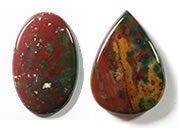 |
Bloodstone |
 |
Rock Tumblers |
 |
Diamond |
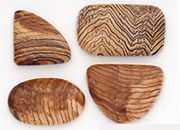 |
Opalized Wood |
 |
Tourmaline |
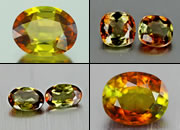 |
Andalusite |
 |
Blue Gemstones |
 |
100+ Gems |

Find Other Topics on Geology.com:

|

| ||

|

| ||

|

| ||

|

|

